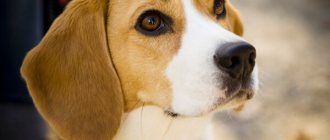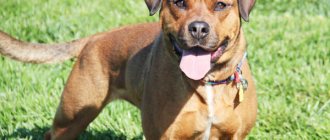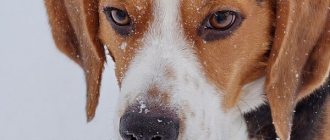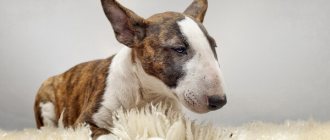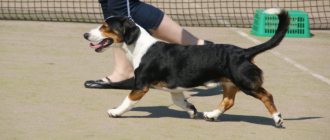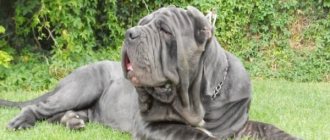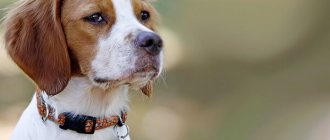Beagle Harriers are French hound dogs, bred specifically for unarmed hunting and famous for their excellent working qualities, strength and endurance, as well as hunting passion and loud, melodious barking.
Today, these dogs are more often bought as pets and devoted companions who become family members.
In our article you will find a detailed description of this breed and its characteristics, as well as photos of these amazing dogs.
History of the breed
Beagle Harriers were bred in France at the end of the 19th century, and the breed standard approved by the FCI was adopted in 1974.
According to the official version, the breed owes its origin to the breeder and breeder Baron Gerard, who crossed 2 breeds of hound dogs - English beagles and harriers.
The goal of the selection was to obtain larger hounds that retained excellent working qualities and were suitable for hunting foxes and hares.
Beagle Harriers combine the best features of both breeds. They got their flair, appearance and endurance from the Harriers, and their sonorous voice, passion for hunting and agility from the Beagles.
At the same time, most dog experts claim that bloodhounds, large Gascony blue hounds, French Pyrenean-type braques and basset hounds were also used when developing the new breed.
Application
The French Beagle was originally bred to track hares and foxes by scent. Now the animal is used in pack hunting for roe deer, deer and rabbits.
The dog runs fast, does not lose its sense of smell at high speed, and is able to follow the trail of blood. Its compact size makes it easy to walk through bushes and track prey in the forest.
This breed does not show high results in sports competitions, has minor guarding qualities, but can become a faithful active companion.
Appearance
The Beagle Harrier is a breed of hunting greyhounds. The height of adult dogs at the withers is 45-50 cm, they weigh on average 19-23 kg, the maximum allowable figure is 25 kg.
Representatives of this breed have a strong, muscular body close to an elongated rectangle, a deep chest, a long neck and a straight, strong back.
Other characteristics of the breed :
- they have straight, strong and muscular paws, set parallel, the paw pads are thick and elastic;
- the head is medium in size with a wide parietal part and a transition from the forehead to the muzzle;
- Hanging, not too long ears are set at eye level and fit tightly to the muzzle; there are small folds in the middle part. The tips of the ears are slightly turned outward;
- the eyes are dark, set wide apart, the nose is straight, the nose is black;
- Beagle Harriers are short-haired dogs. The coat is thick, hard, smooth and shiny, lying close to the body;
- The most common color option is the black-white-red tricolor, but the standard allows other color variations in color.
Childbirth
Labor in Beagles begins 58–62 days after conception and lasts on average 6–12 hours.
If they have not started at this time, you should immediately contact your veterinarian. A few days in advance, you need to take care of the place for delivery. An excellent option would be a large cardboard box with soft bedding away from drafts and radiators. It needs to be equipped so that the mother can easily access her puppies, and they, in turn, feel safe
In the first days after birth, it is not recommended to pay increased attention to newborns. Mom is angry at this time and protects her children
One of the most common postpartum complications is eclampsia. It occurs due to a decrease in calcium levels in the blood. To avoid this, it is necessary to give the bitch a diet with sufficient calcium and vitamin D during pregnancy.
Character traits
Thanks to their balanced and even phlegmatic character, Beagle Harriers easily fit into any family. They do not strive to take a leadership position, they accept the family hierarchy and obey the main thing in the house.
Representatives of this breed are friendly, sociable and completely devoid of aggression, which makes them poor guards - they are too friendly, but at the same time they will be able to protect the owner.
These dogs need constant attention from their owner, love to be the center of attention and cannot stand being alone. Out of boredom, the loud-voiced Beagle Harriers begin to bark and howl loudly.
They are infinitely devoted to their owner and are ready to accompany him everywhere. Sometimes they can be overly intrusive, but they control their behavior if they see that the owner is busy.
Beagle Harriers are active dogs; for harmonious physical and psychological development they require long, regular walks and active games.
These dogs are distinguished by intelligence and intelligence, they are easy to train. At the same time, the hunting instinct determines their independence, stubbornness and independence, which can complicate the process of education and requires patience and perseverance from the owner.
You need to start raising and training a puppy as early as possible, paying special attention to the “come to me” commands, because Beagle Harriers can get carried away by smells while walking and get lost, and “ugh” - to eliminate the possibility of eating something on the street.
Expert opinion
Kozhevin Semyon Kirillovich
Expert dog handler.
As a rule, representatives of this breed are active and courageous, but some individuals have so-called hereditary timidity. This is expressed in excessive timidity, fear of completely harmless things, and hysterics. This happens as a result of poor social adaptation or its complete absence. In general, these are trouble-free dogs that unquestioningly obey their owner and are incredibly loyal to him.
Walks
High physical activity is a natural need for a hound dog, which needs to be supervised during a walk. Do not let your dog off the leash until it has mastered the “Come to me!” command perfectly.
The Harrier requires long walks, allowing the dog to splash out all its accumulated energy.
Advantages and disadvantages
Loyalty and balanced character are not the only advantages of Beagle Harriers; their positive qualities also include:
- lack of aggression;
- friendliness;
- love for children;
- intelligence and intelligence;
- ability to learn;
- cleanliness;
- ease of care and maintenance;
- energy;
- cheerful disposition.
Along with their advantages, these dogs also have a number of disadvantages:
- loud barking;
- possible stubbornness and self-will;
- intolerance of loneliness;
- excessive trustfulness of strangers;
- tendency to obesity and the development of allergic reactions.
CAREFULLY!
The coarse fine hairs of Beagle Harriers can cause bronchospasm, so these dogs should not be owned by those who suffer from bronchial diseases.
Description of the French Beagle
The standard assumes the use of a beagle harrier as a track hound. But recently, more and more often, the hunting and working qualities of the breed fade into the background, and the animals are kept simply as pets and family dogs.
Appearance
The physique of the Beagle Harrier is strong and stocky, perfectly balanced with strong bones and a well-developed muscular corset . The body is elongated, rectangular in format with a short, straight back, deep, round and voluminous chest, strong, slightly arched lower back and a slightly drooping belly (not very toned).
The Beagle Harrier's build is a bit stocky.
Breed standard:
- The not too large head with a voluminous expanded cranial part and a barely noticeable bump on the back of the head is set on a flexible, long, slightly curved neck. The muzzle and skull are approximately equal in length. The muzzle gradually tapers towards the nose (not square). Stop moderate.
- The bridge of the nose is smooth and straight (a hump is not allowed). The large nose is pigmented black.
- The eyes are medium in size, well open. Iris of dark shades. The look is lively, smart and meaningful .
- Short, not very wide, flat hanging ears are placed along the line of the eyes. They fit tightly to the head, slightly turned outward at the ends, and there are shallow folds closer to the middle.
- Straight and strong legs are located parallel. The paws are short, tightly knit with elastic large pads.
- Height at the withers is from 45 to 50 cm.
The French Beagle moves with flexibility, energy and agility.
The thick, medium-length coat fits snugly to the body. The standard allows only a three-color color of white and red (red) with a black saddle . The outlines of the spots are not very clear, the colors of the tan marks vary from dark fawn to brownish-reddish. Gray (smoky) tan and red, white and gray colors are allowed.
The saddle cloth is a dark-colored area on the back, extends to the sides and forms a saddle (cloak).
The standard allows only three-color color of beagle harriers
Disadvantages and disqualifying vices
The following are considered defects or deficiencies:
- heavy or large head;
- too pronounced stop;
- curved bridge of the nose, overly wide open nostrils;
- curled ears;
- undershot or overshot;
- paw spread;
- flat paws;
- heterogeneity of scrotal color (depigmentation);
- effeminacy, timidity or lack of intelligence.
The reasons for disqualification will be:
- cryptorchidism;
- obvious behavioral, mental or physical abnormalities;
- cowardice or aggressiveness.
The difference between the beagle harrier breed and the beagle
Harriers inherited the appearance of beagles from their closest relatives, beagles. All standard characteristics of the breeds coincide almost completely, excluding dimensions. The maximum height at the withers of a beagle should not exceed 40 cm, while its French descendant is larger - its height is about 45–50 cm.
The beagle is smaller than the beagle harrier
At one time, the Beagle Harrier was considered simply a variety of the Beagle, but now it is a separate, albeit very small, breed.
Character and psyche of the breed
The Beagle Harrier is characterized by an affable, open, friendly character and a balanced, rather calm temperament . In ordinary life, this hunting dog is meek, flexible and friendly to everyone without exception. Cases of aggression towards strangers or other dogs are extremely rare. He becomes strongly attached to the entire family in which he lives, especially highlighting the owner. He is ready to tinker and play with children ad infinitum, patiently enduring unceremonious and rude treatment. When the beagle becomes completely unbearable, he will simply run away to a safe distance.
He will always announce the arrival of strangers with a loud bark, but will not show any aggression towards them, since he perceives all people equally positively. Because of this quality, the Beagle Harrier is not suitable for protective purposes. He gets along well with other domestic animals, because these dogs were always kept in packs, and the hounds hunted together as a whole pack. They never make attempts to dominate; they immediately understand the family hierarchy. They are able to make friends with their domestic cats, but neighbor, stray and street cats are always of hunting interest to them.
Beagle Harrier loves to play with his relatives
Dogs do not need authoritarian, strict leadership, since they know what is required of them. But occasionally they tend to be stubborn, act willfully and disobey. Early socialization and timely education will help avoid negative consequences. French beagles have a need for constant communication; they tolerate loneliness very hard. Left alone for a long time, they yearn, whine and howl, and also fill the surroundings with ringing barks. Out of boredom, not knowing what to do with themselves, they can chew on the owner's shoes, furniture or furnishings.
A distant relative had a beagle (American). The dog hated being locked up at home. He sat for hours near the front door, scratching the upholstery, tearing off pieces of dermantine, while barking incessantly. He did not know fatigue; he could bark almost endlessly. He completely forgot about eating, drinking, not to mention sleeping. All shoes had to be put away as high as possible, preferably on the mezzanine, otherwise all that was left of them would be “horns and legs.” In all other respects, he was the sweetest and very affectionate dog.
Video: Beagle Harrier in the apartment
Is it suitable for living in an apartment?
The small size of these dogs allows them to feel quite comfortable in spacious apartments, but they will need to devote a lot of effort and time to raising the pet and walking with it, otherwise it will be impossible to coexist with it in the city.
The most suitable place for keeping Beagle Harriers is a country house with a large yard where the dog can play and spend its energy.
Breeds from the same group
- Australian (kangaroo) greyhound
- Australian Terrier
- Austrian Shorthaired Pinscher
- Azawakh
- Ainu (Hokkaido Inu, Ainu-ken, Hokkaido dog, Hokkaido)
- Akita Inu
- Alopekis
- Alaskan Malamute
- American Blue Gascony Hound (Big and Blue)
- American Indian dog
- American Cocker Spaniel
- American Staffordshire Terrier
- American Toy Terrier (American Toy Fox Terrier)
- American Foxhound (American Foxhound)
- Amur Laika (Indana)
- Anatolian Shepherd
- English Beagle
- English cocker spaniel
- English Pointer (Pointer)
- English Setter (Laverack)
- English Foxhound (Foxhound, American Foxhound)
- Dogo Argentino (Argentine Mastiff, Dogo Argentino)
- Artois Hound (Chien d'Artois)
- Ariège marriage (Ariege pointer, artesien Norman, bracque de Toulouse)
- Afghan Aboriginal Hound (Bakhmul)
- Afghan Hound (Afghan)
- Africanis (lion dogs)
- African hairless dog
- Affen pinscher (monkey pinscher)
- Bakhmul (Afghan Aboriginal Hound)
- Banjar Greyhound
- Basenji (Nyam Nyam Terrier)
- Basset Hound
- Batak Spitz (Pomeranian dog, Batak dog of Sumatra)
- Bedlington Terrier (Rothbury Terrier)
- Beagle Harrier
- Billy (Biya)
- Dogue de Bordeaux (Dogue de Aquitaine, French Mastiff)
- Bosnian Barrack (Bosanski Gonjic, Bosnian Rough-haired Hound, Ke
- Fila Brasileiro (Fila Brasileiro, Brazilian Mastiff, Brazilian Mol
- Breton fawn basset (Breton Basset, Red Breton Basset)
- Bourbon braque
- Buryat-Mongolian wolfhound (Hottosho)
- Wachtelhund (German Spaniel, German Quail Dog)
- Welsh Springer Spaniel
- Welsh Terrier
- Hungarian Greyhound (Magyar Agar)
- Hungarian Vizsla (Vizsla, Hungarian Shorthaired Pointer, Hungarian
- East Siberian Laika
- West Highland White Terrier (West Highland White Terrier, White Highland
- Hanoverian Hound
- Smooth Fox Terrier
- Blue Gascony Griffon
- Hamilton's Hound (Hamiltonstövare)
- Greyhound (English greyhound)
- Greenland dog (Greenland dog)
- Greek hare hound (Hellenic Iknilatis)
- Griffon cortalsa (French Wirehaired Pointer Griffon)
- Jack Russell Terrier
- Jämtland Laika (Emthund, Yemthund, Yamthund, or Swedish Elkhound,
- Wire Fox Terrier
- West Siberian Laika
- Golden retriever
- Irish Water Spaniel
- Irish Wolfhound
- Irish Setter
- Irish Terrier
- Spanish Water Dog (Perro De Acqua Español)
- Italian Segujo (Italian Hound)
- Kai (Brind dog, Kai, Tora Inu, koshu-tora, kai-ken, deer hunting
- Cane Corso Italiano
- Keeshond, Wolfspitz
- Cairn Terrier
- Kerry Blue Terrier
- Kyrgyz Shepherd
- Kishu (Kishu-inu, Kishu-ken)
- Clumber Spaniel
- Cocker Spaniel
- Kromforlander
- Labrador Retriever
- Laika
- Latvian hound
- Levesque
- Lesser Swiss Hound
- Lesser Vendean Basset Griffon (Petit Basset Griffon)
- German Wirehaired Pointer (Drathaar)
- German Hunting Terrier (German Jagdterrier)
- Nova Scotia Retriever (Nova Scotia Duck Retriever, Norwich Terrier
- Norwegian Elkhound (Norwegian Elkhound)
- Norwegian Lundehund (Norwegian Puffin Husky, Norsk Lundehund, Lun
- Norwegian Elghound black
- Ogar (Polish Ogar)
- Otterhound (Otter Hound)
- Parson Jack Russell Terrier
- Pitbull
- Podenco Canario
- Pointer (English Pointer)
- Polish Hound (Polish Ogar)
- Polish ogar
- Portuguese Water Dog (Cao De Acqua)
- Portuguese Podengo
- Poodle
- Rhodesian Ridgeback
- Romanian Mioritic Shepherd Dog
- Russian hunting spaniel
- Russian Spaniel
- Russian-European Laika
- Samoyed dog (Samoyed, Samoyed Spitz)
- Saint-Germain Bracque
- Serbian Hound (Balkan Hound, Yugoslav Hound)
- Stabihon (stabihunzhe, stebihun)
- Taigan (Kyrgyz Greyhound)
- Thai Ridgeback
- Dachshund
- Whippet
- Pharaoh Hound (Pharao Hound, Old Egyptian Greyhound)
- Finnish Hound (Tricolored Finnish Hound, Suomenajokoira)
- French white and orange hound
- Harrier dog
- Cirneco dell'Etna (Sicilian Greyhound)
- Shar Pei
- Silky Windhound (Silky Whippet, Windhound, Small Borhound
- Shikoku (Shikoku, Kochi-ken, Mikawa Inu)
- Styrian hound (Styrian marriage, Styrian rough-haired highland
- Epagnole Pont Audemer
- Airedale
Is he good with children and animals?
Beagle Harriers get along well with children and play with them with pleasure, being aware of the boundaries of what is permitted - they control themselves even when playing with children and will never harm them.
Being pack animals, they get along with other dogs without problems. Problems can arise with cats, but only if they were not raised together.
Nutrition
The Harrier is a breed that is not too picky about food. Can get by with the bare minimum. But the owner should not forget that the diet requires balance. In addition, it should be varied. The dog will need additional mineral supplements. But if we are talking about dry food, then the question disappears: the necessary elements are included in the finished product. Mixing food types is not recommended.
The portions themselves should be small. The calculation is calculated individually. But since the harrier tends to overeat, leftover food should not be given after a while. The pet must wait until the next hourly feeding. For convenience, the bowl should be placed on a stand. This will make eating easier. After feeding, the bowl is removed. But water must be constantly available, especially in summer.
Life expectancy and health
These are quite strong and hardy dogs, with an average life expectancy of 12-15 years. Beagle Harriers rarely get sick, they have good health and strong immunity.
However, there are a number of diseases to which representatives of this breed are susceptible:
- glaucoma;
- epilepsy;
- cataract;
- obesity;
- skin allergic reactions;
- hypothyroidism;
- demodicosis
They are also characterized by diseases of the musculoskeletal system:
- dysplasia of the hip and elbow joints;
- dislocation of the kneecap;
- intervertebral hernia.
NOTE!
You can avoid health problems by conducting routine examinations with a veterinarian.
Dog nicknames: names for Harriers
Most people prefer to choose a short, sonorous name for their dog.
You will have to say your dog's name many times a day, and if it is too long, it will be tiring.
When choosing what to name a harrier, you can be guided by two methods.
- The first and easiest: open the list of the most suitable names for this breed and choose the one that you like best .
- Second: choose an unusual name from other sources, for example, from mythology or literature, name the dog after your favorite celebrity , or come up with your own exclusive name .
There are many suitable names for Harrier girls:
- Anta,
- Bella,
- Bonya,
- Busya,
- Wendy,
- Grace,
- Dana,
- Daphne,
- Dusya,
- Christmas tree,
- Zhuzha,
- Xena,
- Courtney,
- Lovely,
- Malta,
- Marcy,
- Mona,
- Patricia,
- Peggy,
- Reese,
- Sunny,
- Uma.
The following names are good for a boy's harrier:
- Artie,
- Barney,
- Bono,
- Buddy,
- Volt,
- Goofy,
- Garfield,
- Dolphin,
- Ginger,
- Conor,
- Kid,
- Lime,
- Mars,
- Nice,
- Oscar,
- Rich,
- Fox,
- Shine;
Maintenance and care
These dogs love adventure and, upon smelling an interesting scent, will run away without hesitation as soon as the opportunity presents itself. An open gate or a hole in the fence is the path to freedom for them, so the yard in which the Bigd Harrier is kept must be fenced.
Wool and bathing
The coat should be brushed with a stiff, wide-toothed brush 1-2 times a week to get rid of accumulated dust. This should be done more often as it gets dirty or during shedding.
You need to bathe your pet no more than once every 3-4 months, using special shampoos that match the type of coat. Frequent washing dries out the dog's skin and increases the specific dog odor.
Eyes, ears and claws
You need to wipe your dog’s eyes every day with a napkin or cotton pad soaked in a special liquid for eye hygiene. If excessive discharge appears, contact a veterinary clinic.
The hanging, long, pressed to the head and poorly ventilated ears of Beagle Harriers are a favorable environment for the accumulation of bacteria and the development of infections. They must be inspected weekly and cleaned with a special lotion every 2 weeks.
The short nails of these dogs most often wear down during walks. If this does not happen, they must be trimmed monthly with a guillotine nail clipper.
IMPORTANT!
The pet requires regular deworming and treatment for external parasites - fleas and ticks.
Training and education
The Harrier needs socialization, and it is also advisable to take an obedience course. When raising and training, the owner must be firm, fair, and persistent. The training process can be carried out in a playful way. Pets are very fond of dog sports (agility, tracking).
The dog is smart and quick-witted, it is easy to teach commands. However, she tends to be stubborn, so patience will be required. You shouldn't punish her, it's better to try to interest her. You can contact a kennel club, where your pet will be taught all the necessary commands, making him a real companion and hunter.
How to feed?
Beagle Harriers are a “fast-growing” breed of dog, so puppies primarily need proper, balanced nutrition.
The majority of the diet should be protein foods, with carbohydrates in second place; puppies need fat the least. It is also necessary to give your pet vitamins and minerals.
With a natural type of feeding, the majority of the diet, at least 70%, should be lean meat.
The remaining 30% must include:
- porridge;
- vegetables and fruits;
- dairy products;
- sea fish.
For representatives of this breed the following are prohibited:
- legumes;
- fat meat;
- potato;
- pickles, smoked meats, marinades and sweets;
- bones;
- offal.
If the diet consists of ready-made food, it should be premium or super-premium.
The best brands of feed are:
- Orijen;
- Probalance;
- Bosch;
- Eukanuba.
The correctness of the pet’s diet can be judged by the timely change of teeth from milk to molars and the condition of the enamel - its damage indicates a lack of minerals.
NOTE!
Beagle Harriers are prone to obesity, especially with insufficient exercise, so it is necessary to control portion sizes and adhere to a feeding schedule.
Harrier care
Hare hounds do not require any special care. The main set of care measures consists of the following actions:
- combing with a brush or a special silicone mitt (once a week) to remove dead hairs (during the molting period this will need to be done daily);
- rare water treatments (no more than once a quarter) using shampoos for short-haired dogs (BioVax, FitoElita, etc.);
- regular examination of the ears (every 5-6 days), eyes (every day) and wiping them with cotton swabs soaked in special veterinary lotions (Rosinka, Bars, etc.);
- brushing teeth, which the puppy must be accustomed to from childhood, using a small toothbrush and toothpaste that does not require rinsing;
- shortening the claws (once a month), if they do not grind down during walks on their own.
You can feed Harriers both home-cooked, freshly prepared food and factory-made freeze-dried formulas. When choosing dry food, you should give preference to super-premium (or holistic) products intended for active dogs (Eukanuba, Acana, etc.). Adults are given food twice a day (morning and evening), puppies need more frequent feeding (3 to 6 times a day).
ACANA SPORT & AGILITY (ACANA SPORT AND AGILITY) - dry food for active and working dogs of all breeds and ages
A single serving of food must be strictly dosed, since dogs of this breed are prone to overeating and, as a result, obesity.
The natural diet consists of:
- lean meat (horse meat, veal, etc.);
- eggs (chicken and quail);
- porridge (oatmeal, buckwheat, etc.);
- vegetables (raw and boiled);
- fish (sea);
- greenery;
- fruits (apples, pears);
- low-fat fermented milk products (kefir, yogurt, cottage cheese, etc.).
With natural nutrition, vitamin and mineral supplements will need to be introduced into the diet.
Baking, sweets (even as treats), as well as fatty and spicy foods are strictly prohibited.
The harrier feels best when free-ranged
All hounds, including harriers, love freedom, so it is best to keep them in a private house, country cottage or on a farm where there is a spacious yard or enclosure for walking and outdoor games. It is worth worrying in advance about organizing a reliable fence, since these dogs often run free, and also dig the ground and make tunnels. The dog will adapt to apartment life in a small enclosed space, but he will need daily long (at least an hour) active walks with physical exercise and games. On weekends, it is recommended to take your pet out of town so that he can run around to his heart's content and satisfy his innate hunting instincts.
This breed is suitable for people leading an active lifestyle, who can provide their ward with the proper level of physical activity and take him with them for a morning jog, cycling or horseback riding and other outdoor activities.
Training
For Harriers, early socialization and training is extremely important to control their strong hunting instincts. Basic commands should be taught as early as 2–2.5 months; general obedience courses are completed after 5–6 months. Hounds are quite difficult to train; you will need experience working with hunting breeds or the help of a professional instructor. It is better for inexperienced beginners not to undertake this, because they may end up with an uncontrollable and quarrelsome pet.
You need to train your puppy from a very early age.
Well-trained dogs take part in various dog competitions and even in search work.
Video: obedience course for harriers
Price range
Even in France, the homeland of these dogs, their numbers are very small; in Russia there are practically no beagle harriers.
The rarity of dogs of this breed determines their high cost - according to the advertisement, a puppy can be purchased second hand, without a pedigree and other necessary documents, for 15-18 thousand rubles, and the average price in nurseries is 45-50 thousand rubles.
Mating
Certain difficulties will arise with breeding Beagle Harrier dogs, since it is quite difficult to find a worthy partner among the few representatives of the breed in Russia. Most likely, in order to breed a pet, you will have to take it abroad.
General principles of breeding Beagle Harriers:
- The partner must be purebred and have the necessary documents. The class of the male should not be lower than that of the female.
- A female should not be mated during her first heat. It is preferable to allow dogs to breed starting from 2 years of age.
- Mating is carried out on an empty stomach, in the male’s territory or in a neutral place.
- It is advisable to carry out a control mating after 24 hours.
It is necessary to take into account that pet-class dogs are subject to mandatory sterilization and are not allowed to reproduce.
How to choose a puppy?
It is necessary to buy a dog in a specialized nursery from professional breeders - this guarantees the purchase of a healthy and purebred pet.
If you have plans for a show career, you should not buy a dog second-hand, making a choice based on a photo or video.
Before purchasing, it is important to familiarize yourself with all the necessary documents, find out about the health of the puppy’s parents, its vaccinations, and assess the external compliance of the future pet with the breed standard.
In a healthy puppy:
- shiny, elastic coat without bald spots or bald spots;
- eyes, ears, nose are clean, without discharge or unpleasant odor;
- there is no overshot or undershot;
- tight knee joints, confident and coordinated movements.
The puppy should be active, cheerful and curious, without signs of timidity or fear.
IMPORTANT!
Male dogs should not have cryptorchidism.
The most suitable age to buy a dog is 2 months. At this time, the puppy already feeds independently, is less attached to its mother and easily and quickly adapts to new conditions.
Size
Beagle means “small” in English. Accordingly, this dog breed acquired its name due to its short stature. The size of the dog depends on the type of breed. But average values vary from 30 to 40 cm. Weight from 8 to 20 kg.
Standard
Like any breed, the beagle has its own standards. The size of this breed should not be less than 33 cm and no more than 40 cm at the withers. The head is powerful, but at the same time not large. There are no folds on the muzzle. Wide nose, mostly black, but brown nose possible. The ears are soft with rounded tips, set low and close to the cheekbones.
The length of the ears, if you pull them, reaches the tip of the nose. The beagle's tail is strong, even, with a white tassel at the tip, and stands vertically to the ground when moving. The tail should not bend, this will be considered a breed defect. The eyes are shallow-set, large, light brown in color.
Mini
The Mini Beagle has been known since the reign of Elizabeth I. Mini Beagles were so small that they easily fit in a hunting bag on a horse's saddle. But over the years, thanks to the continuous work of breeders, the size of beagles has increased significantly.
Sometimes cunning breeders offer mini-beagles 20–29 cm tall. In fact, this type of breed does not exist, there is official confirmation of this. If there are any abnormalities in the dogs' growth, this is a sign of a "defect", not a pure breed, or the cause of the dog's illness.
Dwarf
On the Internet you can find advertisements for the sale of dwarf beagles. When you come across such advertisements, you should be careful, since the estimated size of the proposed individual is about thirty centimeters. But experienced dog handlers claim that this cannot be and the photographs are most likely processed in a photo editor.
The height of the beagle's withers varies from 33 to 40 cm, according to the standard. But the height of the dog will be greater or less depending on the type of breed, and there are only five of them. If the purpose of your purchase of this dog is breeding or participation in competitions, then be vigilant.
This breed has a certain standard and if the dog is smaller than the standard size, it simply will not be allowed to the exhibition.
But if you do not plan to take your pet to exhibitions, then it does not need to meet the basic standards, and you can rely on the fact that your pet is a dwarf.
There are five main varieties of beagles, with varying color variations, sizes and personalities. The smallest beagles - European ones - are often passed off as a “false” breed - minibeagle or dwarf. But, despite all this diversity, they have one common character trait. The Beagle breed is very friendly, cheerful, energetic, has a keen sense of smell and hunting instincts. So you definitely won’t be bored.
Choosing a puppy and its cost
Despite its antiquity, the breed of mating dogs is not widespread. Some even believe that it is gradually dying out. The breed is common in England, Germany, France, Austria and some other European countries, as well as in Canada and the USA. There are practically no harriers in our country, and it is very difficult to find puppies. Contact your national hunt club who can recommend a good breeder.
Finding a Harrier puppy is quite difficult, since the breed is rare and there are few available puppies.
It is almost impossible to distinguish a Harrier puppy from dogs of related breeds (Foxhound, Beagle or Beagle Harrier), since they differ only in size (adults). Only the pedigree, puppy book and other documents accompanying the breed are a guarantee of purity.
A purebred harrier puppy from a European breeder costs about 500 euros.
